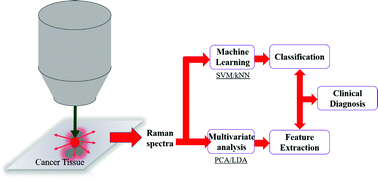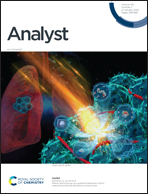Raman spectroscopy as a potential diagnostic tool to analyse biochemical alterations in lung cancer†
Abstract
Patient survival remains poor even after diagnosis in lung cancer cases, and the molecular events resulting from lung cancer progression remain unclear. Raman spectroscopy could be used to noninvasively and accurately reveal the biochemical properties of biological tissues on the basis of their pathological status. This study aimed at probing biomolecular changes in lung cancer, using Raman spectroscopy as a potential diagnostic tool. Herein, biochemical alterations were evident in the Raman spectra (region of 600–1800 cm−1) in normal and cancerous lung tissues. The levels of saturated and unsaturated lipids and the protein-to-lipid, nucleic acid-to-lipid, and protein-to-nucleic acid ratios were significantly altered among malignant tissues compared to normal lung tissues. These biochemical alterations in tissues during neoplastic transformation have profound implications in not only the biochemical landscape of lung cancer progression but also cytopathological classification. Based on this spectroscopic approach, classification methods including k-nearest neighbour (kNN) and support vector machine (SVM) were successfully applied to cytopathologically diagnose lung cancer with an accuracy approaching 99%. The present results indicate that Raman spectroscopy is an excellent tool to biochemically interrogate and diagnose lung cancer.



 Please wait while we load your content...
Please wait while we load your content...